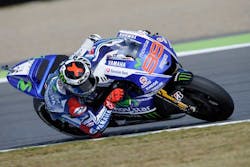The 2015 Japanese Grand Prix was won by a resurgent Dani Pedrosa as he perfectly negotiated a wet, yet drying Motegi circuit to claim victory ahead of Valentino Rossi and Jorge Lorenzo.
Following two days of fine weather on Friday and Saturday, Sunday was subjected to cool and wet conditions with rain falling in the lead up to and at the start of the race before abruptly ceasing, resulting in variable track conditions during the twenty-four lap contest. A new Circuit Best Lap record of 1'43.790 was set in qualifying by Jorge Lorenzo on slick tires – beating the old mark by seven-tenths of a second.
Q&A with Shinji Aoki – Manager, Bridgestone Motorcycle tire Development Department
The main wet tire specification Bridgestone provided was the soft compound option but for the race, almost every rider chose the alternative specification, hard compound wet tire for the front wheel. Why was the soft rear / hard front wet tire combination chosen by so many riders?
“We specified the soft compound wet tire as the main option at Motegi as we generally have low track temperatures at the circuit and compared to some other circuits, it isn’t especially severe on tires. In a practice or qualifying session when riders can use multiple tires, having the soft compound wet tire as the main option makes sense as it offers the best warm-up performance and grip. However, Motegi’s ‘stop and go’ layout not only requires good drive grip out of corners, is also very demanding on the front tire under braking. With the prospect of riding twenty-four laps around Motegi in the wet, it made sense for the riders to choose the hard compound front wet tire for better braking stability and durability, while keeping the soft option on the rear to provide better drive down the straight sections. Although we often see different compound options being selected for the front and rear when slick tires are used, for wet tires this isn’t something we frequently encounter, but at Motegi last Sunday it worked very well.”
Some of the wet tires showed signs of heavy wear at the end of the twenty-four lap race. When the rain stopped during the early stages of the Japanese Grand Prix did you have any concerns that the tires would be able to last race distance?
“I wasn’t too concerned about the durability of our wet tires at Motegi as I knew that if managed well, they can exhibit excellent durability, even on drying asphalt. What was evident after the race was that for many riders, the grooves on their wet tires were quite worn – particularly on the centre section of the tires. However, although the depth of the grooves in some cases was quite low, the actual amount of remaining tread compound was still within the acceptable range for all riders after the race. This is because of the way we design our wet tires, in that we ensure there the tread compound extends well beyond the depth of the grooves. This is why even when the grooves were quite worn, the riders could still lap within a couple of seconds of their best lap time and it was only in the last two or three laps that the riders felt the wet tires weren’t performing as they should. This was due to the compound starting to reach the limit of its operating temperature range as the track was fully dry in some places at the end of the race. However, given what the conditions were I am pleased with how our wet tires performed as it was perhaps the most extreme conditions they had to endure in recent years and it provided us with a lot of valuable data.”
How can you explain the difference in tire wear between the riders? In particular the tires of the riders that finished on the podium, Pedrosa, Rossi and Lorenzo, showed quite a difference in the amount of wear.
“All used race tires exhibit variability in the amount of wear from rider to rider; the difference between slick and wet tires is that due to the groove pattern on wet tires you can visually identify the amount of tire wear. For slick tires, we need to cut cross sections in the tires to measure the amount of tire wear. Visually, the difference in tire wear between the riders on front row was easy to identify and this came down to the different tire management strategies, riding styles and bike settings of the competitors. Jorge was very quick at the start of the race in the fully wet conditions, lapping up to a second quicker than the other riders and so in the closing stages of the race, experienced more of a drop-off in performance than Valentino and Dani. On the other hand, Dani and Valentino had a slow start but that meant they could push harder later in the race as their tires were in better shape in the final laps.”



